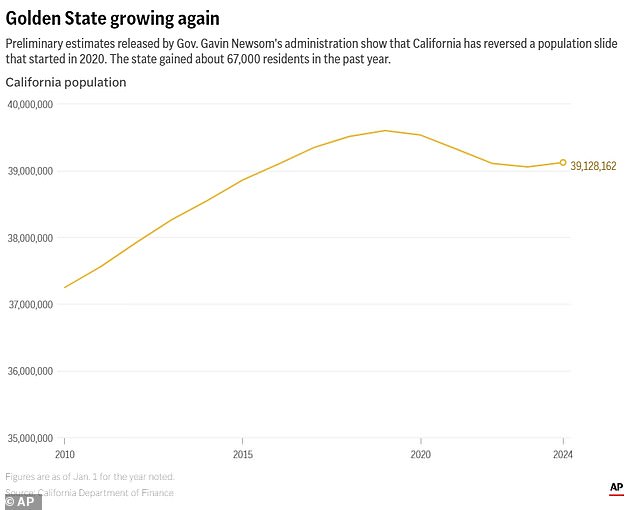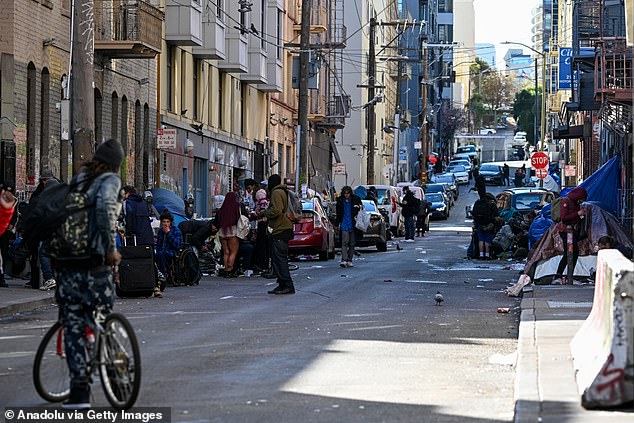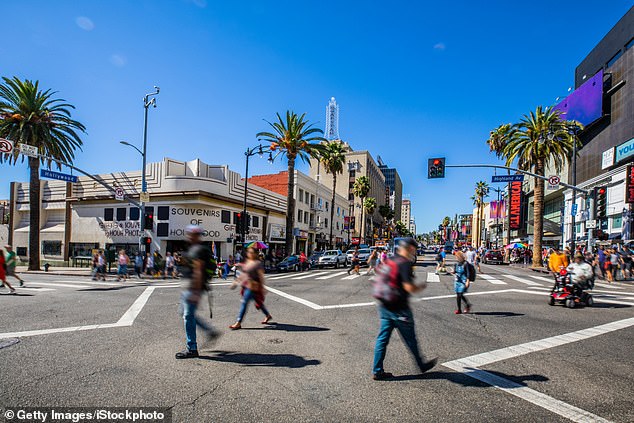In recent years, California has been plagued by rampant homelessness, drug addiction and exorbitant costs of living that forced residents to migrate en masse to Arizona, Texas and elsewhere.
Now it appears the Golden State is bouncing back.
California grew by about 67,000 people last year, its first increase since 2019, according to an estimate from the state Department of Finance.
This ends a population decline that has dogged Gov. Gavin Newsom, widely considered a future Democratic presidential candidate, for much of his term.
California grew by about 67,000 people last year, and the crowd is on Hollywood Boulevard in Los Angeles.

Home construction has increased in California, but costs remain well above the national average
The small increase represents only a 0.17 percent growth rate.
This is in no way an increase.
But officials say this signals a return to steady population growth after years of disruption from Covid-19.
Newsom took a victory lap.
“People from all over the country and the world are coming to the Golden State to pursue the California dream,” he said.
On the West Coast, “they can experience the success of the fifth largest economy in the world,” he added.
The population increase is attributed to more people immigrating to California from abroad.
Additionally, fewer people are dying from the coronavirus pandemic and fewer people are leaving California to seek a cheaper life elsewhere.
Legal immigration to California from other countries plummeted during the pandemic amid stricter rules under then-President Donald Trump.
It recovered in 2023 with a net gain of 114,200 people, almost to pre-pandemic levels.
State officials called it a “stable foundation for continued growth.”

Democratic Gov. Gavin Newsom says people are coming back for the ‘California dream’

State Assembly Republican Leader James Gallagher Says Newsom Should Stop ‘Boasting’
But that growth will likely be much smaller than in past decades, said Eric McGhee, an expert at the Public Policy Institute of California.
“It’s going to be better for the state in terms of its total population,” McGhee said.
But California is still set to lose “more congressional districts in the 2030 census,” he added.
In 2023, even more people left California for other states than moved to California from other states, but it was much fewer than in previous years.
In 2021, as coronavirus cases continued to rise and more people worked remotely, California lost a net 355,648 people due to domestic migration.
Last year, that number dropped to 91,189, closer to pre-pandemic levels.
Still, Newsom’s critics say California is not out of the woods yet.
The state continued to suffer from high costs of living, uncertain power supplies, a housing and homelessness crisis, and widespread concerns about crime.
The return to population growth does not appear to be a revival of the state’s impressive growth streak in the 19th and 20th centuries.
“For the governor to brag about that is kind of like the guy who lost thousands of dollars at the casino last night bragging about winning $20 at the blackjack table,” joked James Gallagher, the Republican leader in the state Assembly.

California grew by about 67,000 people last year, its first increase since 2019

More people means more homelessness: California has the worst levels of homelessness of any US state.
‘I don’t understand why the governor and the Democratic supermajority continue to turn a blind eye to this. They act as if nothing is happening when there are a lot of things wrong.’
California’s gas prices, utility bills, and housing costs are among the highest in the country.
The state’s homeless problem has only gotten worse even though lawmakers have committed billions of dollars to the problem.
California is also in the midst of consecutive multibillion-dollar budget shortfalls.
Newsom’s efforts to reduce living costs, including trying to reduce some medical expenses, are a drop in the ocean.
Critics say California’s heyday is in the rearview mirror.
After joining the United States in 1850, immediately after the gold rush, California was a demographic marvel for its first 169 years: increasing population every year.
People flocked to the Golden State for its stunning terrain, climate and large economy, which is larger than that of all but four countries.
That streak ended in 2020, when California lost population for the first time, in a crucial census year in which the state lost a congressional seat.
Over a two-year period, Californians moving to Texas made up the largest flow of people from one state to another in the United States, census data show.
The state’s population growth estimate appears to contradict recent Census Bureau figures.
The state estimate was based on several factors, including births and deaths, address changes on driver’s licenses, vehicle registration and enrollment in the government-funded health insurance programs Medicaid and Medicare.
With agencies.


